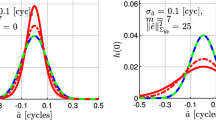Abstract
A priori variance–covariance matrix (VCM) estimation of global navigation satellite systems (GNSS) double difference observations in relative positioning is challenging. Existing methods have been limited to estimate variances only or present variables challenging to acquire a priori, unfeasible for observation planning. Ignoring the covariances produces misleading results and compromises reliance on GNSS positioning design. In this study, we propose models to estimate the VCM a priori for planning, based on simple variables accessible to any professional: observation time span, vector length, and ephemeris type. Using a database of over 140,000 GNSS vectors with double difference (DD) observations, we group the data by time span and length range and extract standard deviations and covariances for the linear regression process. The Isolation Forest algorithm is employed to filter outlying observations. Our models provide standard deviations and root square covariances in a local coordinate system, requiring only vector length, observation time span, and ephemeris type as input. Additionally, the equations can be easily implemented in a simple spreadsheet. The results show high coefficients of determination (R2 > 0.8). We tested the models in a simulated GNSS network and verified broadcast ephemeris resulted in 6.5 to 16.7 times larger error ellipsoids compared to the precise ephemeris, indicating higher uncertainty. Ellipsoids differed in flattening and orientation when compared to the null covariance (variance only) approach. Although VCM models better reflect the precision of relative positioning observations, they did not affect the number of non-controllable observations in the observation’s reliability tests.









Similar content being viewed by others
Data availability
The datasets generated during and analyzed during the current study are available from the corresponding author upon reasonable request.
References
Dogan B, Ölmez T (2015) A new metaheuristic for numerical function optimization: vortex search algorithm. Inf Sci 293(125–145):S0020025514008585. https://doi.org/10.1016/j.ins.2014.08.053
Eckl M, Snay R, Soler T (2001) Accuracy of GPS-derived relative positions as a function of interstation distance and observing-session duration. J Geodesy 75:633–640. https://doi.org/10.1007/s001900100204
El-Rabbany A (1994) The effect of physical correlations on the ambiguity resolution and accuracy estimation in GPS differential positioning. Ph.D. Thesis, University of New Brunswick, Department of Geodesy and Geomatics Engineering, Fredericton, NB
Erdogan B, Dogan AH (2019) Scaling of the variance covariance matrix obtained from Bernese software. Acta Geod Geoph 54:197–211. https://doi.org/10.1007/s40328-019-00252-w
Firuzabadì D, King RW (2012) GPS precision as a function of session duration and reference frame using multi-point software. GPS Solutions 16:191–196. https://doi.org/10.1007/s10291-011-0218-8
Gatti M (2004) An empirical method of estimation of the variance—Covariance matrix in GPS network design. Surv Rev 37:531–541. https://doi.org/10.1179/sre.2004.37.293.531
Geng J, Meng X, Teferle FN, Dodson AH (2010) Performance of precise point positioning with ambiguity resolution for 1- to 4-hour observation periods. Surv Rev 42(316):155–165. https://doi.org/10.1179/003962610X12572516251682
Gökdaş Ö, Özlüdemir MT (2020) A Variance model in NRTK-based geodetic positioning as a function of baseline length. Geosciences 10:262. https://doi.org/10.3390/geosciences10070262
Gond AK, Ohri A, Maurya SP, Gaur S (2023) Accuracy assessment of relative GPS as a function of distance and duration for CORS network. J Indian Soc Remote Sens 51:1267–1277. https://doi.org/10.1007/s12524-023-01701-4
Kashani I, Wielgosz P, Grejner-Brzezinska DA (2004) On the reliability of the VCV Matrix: A case study based on GAMIT and Bernese GPS Software. GPS Solutions 8:193–199. https://doi.org/10.1007/s10291-004-0103-9
Kermarrec G, Schön S (2016) Taking correlations in GPS least squares adjustments into account with a diagonal covariance matrix. J Geodesy 90:793–805. https://doi.org/10.1007/s00190-016-0911-z
Koch IÉ, Klein I, Gonzaga L, Matsuoka MT, Rofatto VF, Veronez MR (2019) Robust estimators in geodetic networks based on a new metaheuristic: independent vortices search. Sensors 19:4535. https://doi.org/10.3390/s19204535
Koch IÉ, Klein I, Gonzaga L, Rofatto VF, Matsuoka MT, Monico JF, Veronez MR (2022) GNSS vector quality modelling combining Isolation Forest and Independent Vortices Search. Measurement 189:110455. https://doi.org/10.1016/j.measurement.2021.110455
Leick A, Rapoport L, Tatarnikov D (2015) GPS satellite surveying. John Wiley & Sons Inc, Hoboken, NJ, USA. https://doi.org/10.1002/9781119018612
Liu FT, Ting KM, Zhou ZH (2008) Isolation forest. In: Proceedings—IEEE International Conference on Data Mining, ICDM, pp. 413–422. https://doi.org/10.1109/ICDM.2008.17
Liu FT, Ting KM, Zhou ZH (2012) Isolation-based anomaly detection. ACM Transactions on Knowledge Discovery from Data 6. https://doi.org/10.1145/2133360.2133363
Öğütcü S, Kalaycı İ (2018) Accuracy and precision of network-based RTK techniques as a function of baseline distance and occupation time. Arab J Geosci 11:354. https://doi.org/10.1007/s12517-018-3712-2
Ozturk D, Sanli DU (2011) Accuracy of GPS positioning from local to regional scales: a unified prediction model. Surv Rev 43(323):579–589. https://doi.org/10.1179/003962611X13117748892191
Prószyński W (2010) Another approach to reliability measures for systems with correlated observations. J Geodesy 84:547–556. https://doi.org/10.1007/s00190-010-0394-2
Schwieger V (2007) Determination of synthetic covariance matrices—An application to GPS monitoring measurements. In 2007 15th European Signal Processing Conference (pp. 1161–1165). IEEE
Soler T, Michalak P, Weston N, Snay RA, Foote RH (2006) Accuracy of OPUS solutions for 1- to 4-h observing sessions. GPS Solutions 10:45–55. https://doi.org/10.1007/s10291-005-0007-3
Soycan M, Ocalan T (2011) A regression study on relative GPS accuracy for different variables. Surv Rev 43(320):137–149. https://doi.org/10.1179/003962611X12894696204867
Acknowledgements
Partial financial support was received from Coordenação de Aperfeiçoamento de Pessoal de Nível Superior—Brasil (CAPES)—Finance Code 001. Also, a CNPq productivity grant, process 313699/2021-6, for Ivandro Klein.
Author information
Authors and Affiliations
Contributions
I.E.K, I.K. and M.R.V. wrote the main manuscript text. I.E.K prepared all figures and tables. All authors reviewed the manuscript and participated in the research.
Corresponding author
Ethics declarations
Competing interests
The authors declare no competing interests.
Additional information
Publisher's Note
Springer Nature remains neutral with regard to jurisdictional claims in published maps and institutional affiliations.
Rights and permissions
Springer Nature or its licensor (e.g. a society or other partner) holds exclusive rights to this article under a publishing agreement with the author(s) or other rightsholder(s); author self-archiving of the accepted manuscript version of this article is solely governed by the terms of such publishing agreement and applicable law.
About this article
Cite this article
Koch, I.É., Klein, I., Gonzaga, L. et al. Metaheuristic-based stochastic models for GNSS relative positioning planning. GPS Solut 28, 15 (2024). https://doi.org/10.1007/s10291-023-01562-x
Received:
Accepted:
Published:
DOI: https://doi.org/10.1007/s10291-023-01562-x




